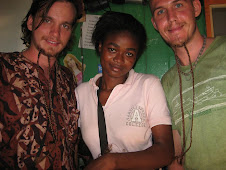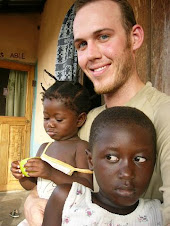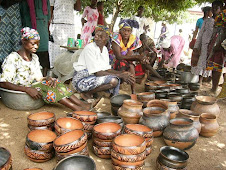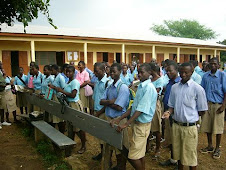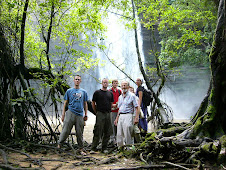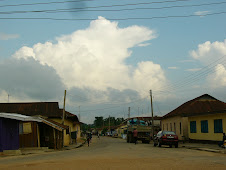Hey all,
So almost everyone in Ghana it seems has a cell phone. There are about four major companies competing and service is pretty much available everywhere, even in remote little villages like Sirigu. It is all pay as you go, that is, you buy units and add them to your phone, then as you make calls the units get used up. The prices are pretty good and there are lots of different kinds of phones around, some very fancy. Mine isn't fancy, but it has an excellent feature: It has a flashlight built into it. This is particularly useful for me because my house doesn't have electricity. In small villages like mine, most people do not have electricity in their houses. Also to note: roads are not paved, no piped water, outdoor toilets only (mine is actually inside, but with no water, I have to use a bucket to flush), and overall poverty compared with the standard of living you are probably used to.
So why this apparent paradox? Ladies selling food off their heads in the market have cell phones? It's just an example of the success of private enterprise, I guess. The cell phone companies are all private and competing, so the quality and availability of the service is pretty good. There are cell towers all over Ghana, there's one in Sirigu and one in Kandiga (where Shauna lives, 20 min bike away). Advertising campaigns have convinced people that they should have a mobile phone, so some eat poorly or little and wear broken flipflops in order to buy phone units. It's just the way it goes. Of course to charge your phone, you take it to your friend who has lights. Electricity and water are controlled by the National Government, and seem much slower to develope and extend service, although it is coming. We may get water and power to the school by next year if we are lucky. The students would like that...
I suppose cell phones are getting more and more common now in the US. How about it? Does every junior high school kid have his own cell? My students can't bring theirs to school, and if they do they get confiscated. I'm always looking for a new phone, I tell them.
One other note. The technology is here, but the culture and ethics of mobile phones is a bit different here. It is not uncommon for someone to answer their phone during a meeting, or interrupt you to talk on the phone. Ghanaians listen to music on their phones a lot, many have mp3 or radios in them. Also, because there is no voice mail, someone may call you repeatedly when you don't answer, like 15 times in a row. That's not an exaggeration. It's usually just better to answer since they probably only want to greet you and talk for a minute or two about your dog. oh well.
And the dog: sorry to let you all know that Kraman Baa has died. It happened a little while ago, and I was avoiding telling everyone at home. I was sad, but now I'm okay. She had been sick, and then one day she went up to the big kennel in the sky. I asked Robert and he said that dogs can't go to Heaven because animals have no souls. I'm not worried. I decided to give Kraman Baa a traditional Ghanaian dog funeral. Ask if you really want to know what that means.
Love to all,
-Toby
Thursday, March 26, 2009
Sunday, March 22, 2009
Food!
I'll tell y'all a little about the traditional foods that people eat around here. Around here is northern Ghana, specifically the Upper East Region, because that's what I know and that's where I am. Other parts of the country do it a little differently, and the southern half of the country is significantly different culturally and culinarily, but you'll get the idea.
Ingredients are fairly limited around here, so people make due with what they have. A basic meal is usually made up of a dense carbohydrate and a vegetable based stew or soup. Basic ingredients available: tomatoes, onions, garlic, ginger, oil, groundnuts (that's peanuts), okra, peppe (little, very hot peppers). Another ingredient that is in most things is maggi cubes (commercial bullion seasoning) but I don't use that much.
The most typically northern food is called TZ (pronounced Tee Zed), which stands for "Toa Zhafi", the name in Hausa (widely spoken west african langauge). In Frafra, the food is called "sagebo" (pronounced sah-gay-boh. TZ is made from flour and water and can be made of maize, millet, or wheat flour. I like the maize TZ the best, and that's the kind that Robert makes most often, and is teaching me to make. Water is mixed with a small amount of flour and heated to boiling. Some of the flour water is removed and then lots of flour is added to the pot. Stirring continuously, the watery mixture is added a little at a time to make a thick cream-of-wheat consistancy. You have to stir constantly or it will burn, so it is cooked on the ground. Specially made metal hooks are put through the handles of the thick cast aluminium pot and the ends of the hooks are held with the feet, to keep the pot steady. Both hands are used to stir with a big wooden spoon/paddle. When the TZ is ready and the right thickness, it is poured into bowls and plates and allowed to cool. As it cools, it gets thicker and thicker until it can be eaten by breaking pieces off the main lump. It reminds me of semi solid cream-of-wheat cereal. It can also be made with slightly fermented flour water, or boiled seeds and tree bark can be added for a certain flavor that I don't really like.
When you eat it, you use your hands, of course, and only your right hand. I break off pieces of TZ and dip/scoop up some soup to go with it. TZ is best with okra stew or groundnut with Aleefu stew. Both of these are tomatoe based, with onion, peppe, and oil, okra strew has boiled cut up okra, which becomes very slimy and stringy. It's kind of like snot, and takes some getting used to. Okra stew is mostly only eated with TZ. Aleefu is a leaf (looks similar to a maple leaf) that is boiled and is similar to spinach when cooked. Canned fish is sometimes added to this one. Groundnut paste (peanut butter? it's not butter!) is added to make the soup smooth and creamy. Yum!
Rice balls are made by stirring rice cooked with a little extra water. It becomes a thick paste that is then made into balls (tennis to soft sized) and allowed to cool. It is eaten the same way as TZ with groundnut soup.
Banku is fermented corn dough formed into balls and eaten with the hands along with light soup or sometimes okra stew. Kenke is also fermented corn dough that is wrapped in corn husks (Gaa kenke) or plantain leaves (Fanti kenke) and boiled for some time. The names refer to the tribes that originally made them, but they are both common here and neither tribe is from the north. Kenke is eaten with a bit of tomanto stew or some peppe sauce (like salsa). Fufu is made by pounding boiled cassava, plantain, yam, or a combination of two until it becomes a dense sticky doughy lump. Fufu isn't northern, but people make it here sometimes. It's usually eaten with light soup, which is (as the name implies) a light tomato-based soup with plenty of oil and peppe.
Along with these foods, rice is very common: Plain rice with tomanto-vegetable stew, fried rice with a few veggies in it, and jolloff rice (rice cooked in a spicy tomato-fish sauce). Chicken, fish, or meat (usually goat) is normally offered as well. If you go to chop bar (food stand on the street) they may give you some "salad" with your rice which consists of shredded cabbage and lettuce, carrots, green peppers and some mayonaise-ish salad cream.
At home, when I cook "ghanaian" or when Robert cooks, we have rice and stew, TZ, and rice balls most of the time. When I cook for myself, I tend to make some variation on macaroni and cheese.
I'm eating well and enjoying the food here. An interesting note on "table manners": very different expectations here. When you eat with your hands, you naturally tend to hunch over your bowl. In Ghana, it is seen as rude to talk during a meal and very rude to reach into a communal bowl with your left hand. Also, you always bring food to your mouth with your right hand.
Try this next time you are eating with tolerant people. A rice dish is a good one to practice with: Hunch over your plate and put your left hand in your lap. Wash your right hand and put your right elbow on the table so that you can reach your food with your hand. Mix your food around and play with it a little (eating has now become a tactile experience!). Pick up some rice in your hand and hold it on your last three fingers. If you want, you can squeeze it to keep it together. Cock your wrist so that your last three fingers point towards your mouth and act like a spoon. Put the food in your mouth, push it off your fingers with your thumb. Lick your fingers often. You can eat anything this way, but if it is a very thin soup, just pick up the bowl and drink it after you've finished your TZ.
Food is fun, and I look forward to cooking and eating Ghanaian food with you, my loved ones, when next we meet. Take care of yourselves and eat well.
Love,
-Toby
Ingredients are fairly limited around here, so people make due with what they have. A basic meal is usually made up of a dense carbohydrate and a vegetable based stew or soup. Basic ingredients available: tomatoes, onions, garlic, ginger, oil, groundnuts (that's peanuts), okra, peppe (little, very hot peppers). Another ingredient that is in most things is maggi cubes (commercial bullion seasoning) but I don't use that much.
The most typically northern food is called TZ (pronounced Tee Zed), which stands for "Toa Zhafi", the name in Hausa (widely spoken west african langauge). In Frafra, the food is called "sagebo" (pronounced sah-gay-boh. TZ is made from flour and water and can be made of maize, millet, or wheat flour. I like the maize TZ the best, and that's the kind that Robert makes most often, and is teaching me to make. Water is mixed with a small amount of flour and heated to boiling. Some of the flour water is removed and then lots of flour is added to the pot. Stirring continuously, the watery mixture is added a little at a time to make a thick cream-of-wheat consistancy. You have to stir constantly or it will burn, so it is cooked on the ground. Specially made metal hooks are put through the handles of the thick cast aluminium pot and the ends of the hooks are held with the feet, to keep the pot steady. Both hands are used to stir with a big wooden spoon/paddle. When the TZ is ready and the right thickness, it is poured into bowls and plates and allowed to cool. As it cools, it gets thicker and thicker until it can be eaten by breaking pieces off the main lump. It reminds me of semi solid cream-of-wheat cereal. It can also be made with slightly fermented flour water, or boiled seeds and tree bark can be added for a certain flavor that I don't really like.
When you eat it, you use your hands, of course, and only your right hand. I break off pieces of TZ and dip/scoop up some soup to go with it. TZ is best with okra stew or groundnut with Aleefu stew. Both of these are tomatoe based, with onion, peppe, and oil, okra strew has boiled cut up okra, which becomes very slimy and stringy. It's kind of like snot, and takes some getting used to. Okra stew is mostly only eated with TZ. Aleefu is a leaf (looks similar to a maple leaf) that is boiled and is similar to spinach when cooked. Canned fish is sometimes added to this one. Groundnut paste (peanut butter? it's not butter!) is added to make the soup smooth and creamy. Yum!
Rice balls are made by stirring rice cooked with a little extra water. It becomes a thick paste that is then made into balls (tennis to soft sized) and allowed to cool. It is eaten the same way as TZ with groundnut soup.
Banku is fermented corn dough formed into balls and eaten with the hands along with light soup or sometimes okra stew. Kenke is also fermented corn dough that is wrapped in corn husks (Gaa kenke) or plantain leaves (Fanti kenke) and boiled for some time. The names refer to the tribes that originally made them, but they are both common here and neither tribe is from the north. Kenke is eaten with a bit of tomanto stew or some peppe sauce (like salsa). Fufu is made by pounding boiled cassava, plantain, yam, or a combination of two until it becomes a dense sticky doughy lump. Fufu isn't northern, but people make it here sometimes. It's usually eaten with light soup, which is (as the name implies) a light tomato-based soup with plenty of oil and peppe.
Along with these foods, rice is very common: Plain rice with tomanto-vegetable stew, fried rice with a few veggies in it, and jolloff rice (rice cooked in a spicy tomato-fish sauce). Chicken, fish, or meat (usually goat) is normally offered as well. If you go to chop bar (food stand on the street) they may give you some "salad" with your rice which consists of shredded cabbage and lettuce, carrots, green peppers and some mayonaise-ish salad cream.
At home, when I cook "ghanaian" or when Robert cooks, we have rice and stew, TZ, and rice balls most of the time. When I cook for myself, I tend to make some variation on macaroni and cheese.
I'm eating well and enjoying the food here. An interesting note on "table manners": very different expectations here. When you eat with your hands, you naturally tend to hunch over your bowl. In Ghana, it is seen as rude to talk during a meal and very rude to reach into a communal bowl with your left hand. Also, you always bring food to your mouth with your right hand.
Try this next time you are eating with tolerant people. A rice dish is a good one to practice with: Hunch over your plate and put your left hand in your lap. Wash your right hand and put your right elbow on the table so that you can reach your food with your hand. Mix your food around and play with it a little (eating has now become a tactile experience!). Pick up some rice in your hand and hold it on your last three fingers. If you want, you can squeeze it to keep it together. Cock your wrist so that your last three fingers point towards your mouth and act like a spoon. Put the food in your mouth, push it off your fingers with your thumb. Lick your fingers often. You can eat anything this way, but if it is a very thin soup, just pick up the bowl and drink it after you've finished your TZ.
Food is fun, and I look forward to cooking and eating Ghanaian food with you, my loved ones, when next we meet. Take care of yourselves and eat well.
Love,
-Toby
Saturday, March 14, 2009
More photos and stuff
photos on facebook, now with captions!
I saw an abyssinian roller the other day. beautiful. use google image search to find a better picture than i could ever take.
Anthony, another PCV in the Western Region told me that he saw one of his students wearing a SPASH 2002 t shirt. Amazing, that's even the year I graduated. Cloths from the US that no one wants in the thrift stores gets bundled up and sent to Africa. Here, people call it "obruni wayru" which means "dead white man's cloths". That's because people think the only reason some would get rid good cloths is if they died. I see people wearing all kinds of strange second hand clothes, mostly they have no idea what the thing means. I've seen some pretty funny ones too, like an old man wearing a pink shirt that says "That's Miss Bitch to You!" or a housewife wearing "Eat, Sleep, Fish" Shirts with other people's names on them are popular too. I guess that's true in the US as well.
Happy St. Patties day coming up. I celebrated this weekend with some Irish volunteers in Navrongo, Mary and Sarah. They sang Irish songs and taught us an Irish dance and Mary played a tune on a tin whistle, an Irish instrument. It was lots of fun. We drank and danced a lot.
Happy birthday, mom. I love you.
-Toby
I saw an abyssinian roller the other day. beautiful. use google image search to find a better picture than i could ever take.
Anthony, another PCV in the Western Region told me that he saw one of his students wearing a SPASH 2002 t shirt. Amazing, that's even the year I graduated. Cloths from the US that no one wants in the thrift stores gets bundled up and sent to Africa. Here, people call it "obruni wayru" which means "dead white man's cloths". That's because people think the only reason some would get rid good cloths is if they died. I see people wearing all kinds of strange second hand clothes, mostly they have no idea what the thing means. I've seen some pretty funny ones too, like an old man wearing a pink shirt that says "That's Miss Bitch to You!" or a housewife wearing "Eat, Sleep, Fish" Shirts with other people's names on them are popular too. I guess that's true in the US as well.
Happy St. Patties day coming up. I celebrated this weekend with some Irish volunteers in Navrongo, Mary and Sarah. They sang Irish songs and taught us an Irish dance and Mary played a tune on a tin whistle, an Irish instrument. It was lots of fun. We drank and danced a lot.
Happy birthday, mom. I love you.
-Toby
Subscribe to:
Posts (Atom)

